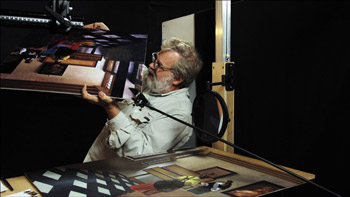Tim's Vermeer

Tim's Vermeer
Cast: Tim Jenison, Penn Jillette, Colin Blakemore
Director: Teller
Genre: Documentary
Rated: M
Running Time: 80 minutes
Synopsis: Tim's Vermeer, directed by Teller of Penn and Teller fame. Produced by Teller's stage partner Penn Jillette and Farley Ziegler, the film follows Tim Jenison, a Texas based inventor, as he attempts to solve one of the greatest mysteries in all of art: How did 17th century Dutch Master Johannes Vermeer ('Girl with a Pearl Earring') manage to paint so photo-realistically, 150 years before the invention of photography? Jenison's epic research project ultimately succeeds as he uses 17th century technology - lenses and mirrors - to develop a technique that might have been used by Vermeer, supporting a theory as extraordinary as what he discovers. Spanning a decade, Jenison's adventure takes him to Delft, Holland, where Vermeer painted his masterpieces; on a pilgrimage to the North coast of Yorkshire to meet artist David Hockney; and eventually even to Buckingham Palace, to see the Queen's Vermeer.
Tim's Vermeer
Release Date: July 3rd, 2014
About the Production
Who is Tim?
Tim Jenison was the visionary behind the desktop video revolution. Jenison founded NewTek in 1985, and led the way in the development of a series of highly successful products, including DigiView (one of the first video digitisers for a computer), DigiPaint, and the Video Toaster®. Tim Jenison saw the personal computer as the mode for incorporating his various interests: electronics, music, film and video. Prior to setting out on the journey this film depicts, Tim had a foundation in the science of digital art. However, he had never painted before and certainly did not consider himself to be a painter.
The Mystery of Vermeer
During the late 1650s, Vermeer and other Dutch artists began to place a new emphasis on depicting figures within carefully composed interior spaces. Vermeer's works are small and rare. Of the 35 paintings attributed to him, all of them are admired for the detail in which he rendered the effects of light and color. Little is known for certain about Vermeer's career. His earliest signed and dated painting, The Procuress (1656), is thematically related to a Dirck van Baburen painting that Vermeer owned and that appears in the background of two of his own paintings. After his death Vermeer was overlooked by all but the most discriminating collectors and art historians for more than 200 years. Only after 1866, when the French critic Théophile Thoré-Bürger rediscovered him, did Vermeer's works become widely known.
Tim's Vermeer is not the first look into Vermeer's likely use of optics in his works. Professor Philip Steadman (seen in the film) caused a sensation in the art world in 2001 when he published his book Vermeer's Camera. Steadman investigated the suspicions of art historians who suggested Vermeer used a camera obscura, an optical device that could project the image of sunlit objects placed before it with extraordinary detail. However, Steadman's experiment used a technique known as 'reverse perspective" which produced startling results. He found that six of the Vermeer paintings he analysed depicted the same room, the painter's studio in Delft, and the geometry of the six was consistent with their being projected on to the back wall of the room using a lens and then traced. 
These findings were not intended to challenge Vermeer's genius but rather to show how, like many artists, Vermeer was able to use technology to paint his extraordinary compositions more accurately. Nevertheless, Steadman's book caused a storm of controversy, dividing art historians while convincing many scholars in the history of science, technology, optics and photography.
Art vs. Science … that is the question
The questions posed by this discovery all come back to the debate of whether the use of these technologies negatively impacts Vermeer's reputation as an artist. Some would say that this was cheating. Others would say that this was innovation. David Hockney, author of Secret Knowledge: Rediscovering Techniques of the Old Masters (seen in the film), attributes some of the controversy to the contemporary separation of art and science. Hockney reminds us that in Vermeer's time art and science were much more closely intertwined, for example Vermeer's neighbor was a master microscope maker who could have taught Vermeer about optics. Some speculate that using technology such as the camera obscura, a device akin to a modern photographic camera, would make Vermeer less of an artist. Though today, we consider individuals who are highly skilled in photography to be great artists. How can the two beliefs be held simultaneously? Questions remain that if Vermeer had used optical technology, why would there be no written records of it? Possibly the paintings themselves tell the story.
It's about the process, not the product
The film takes the viewer on the journey of Tim Jenison's experiment to test theories of how the great seventeenth-century Dutch artist, Johannes Vermeer, was able to capture light in his paintings with such photographic quality. This experiment, as with all others, begins with a hypothesis, a question. Tim's questions stem from the over 100 years of speculation and controversy surrounding claims that Vermeer used a camera obscura to create these famous images. However, quickly Tim determines that the camera obscura alone was not sufficient to capture the range of color and tones that are the heart and soul of Vermeer's paintings. How could the technologies of Vermeer's time have been combined to assist him in capturing light variations that are not visible to the naked eye?
The film explores how Tim came up with, and then tested, his idea of using a mirror to allow the artist not only to trace the shapes but to precisely duplicate the color of real objects. Using a combination of a camera obscura and two mirrors – equipment that would have been easily available in Vermeer's Holland - Tim created a device (depicted above) that allowed him to paint in the same manner as Vermeer. Tim Jenison, a man who had never painted before, with the use of his device, attention to detail, and patience, was immediately able to paint with astonishing, Vermeer-like accuracy. Each time it worked it surprised all who witnessed it. It was as if it were a magic trick.
Tim next set about selecting one of the Vermeer pictures, then replicating the scene depicted in the painting and the conditions under which Vermeer painted, as closely as possible. Tim chose The Music Lesson. In his warehouse in Texas, Tim handmade the lens, hand crafted the paint and pigments, calculated and designed the room, built replicas of the furniture and all of the objects in the room, etc.
The film depicts the massive undertaking of this process, and all that had to occur before Tim could even pick up a paintbrush. Tim discovered that using the device did eliminate some of the decision making for the painter such as: what color to use, when to adjust the tone quality and where to start and stop a line. However, it was far from an easy process. Painting with this method required a certain level of obsession in the painter's attention to detail. It was slow, meticulous and often backbreaking work for the painter and the models. Tim spent 130 days painting in this manner.
His results – and the startling evidence he uncovered in the process – could change the history of art forever.
Tim's Vermeer
MORE
- Mission: Impossible Fallout
- Glenn Close The Wife
- Allison Chhorn Stanley's Mouth Interview
- Benicio Del Toro Sicario: Day of the Soldado
- Dame Judi Dench Tea With The Dames
- Sandra Bullock Ocean's 8
- Chris Pratt Jurassic World: Fallen Kingdom
- Claudia Sangiorgi Dalimore and Michelle Grace...
- Rachel McAdams Disobedience Interview
- Sebastián Lelio and Alessandro Nivola...
- Perri Cummings Trench Interview



